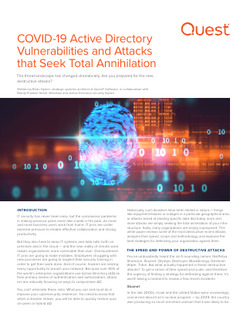The threat landscape has changed dramatically. Are you prepared for the new destructive attacks?
IT security has never been easy, but the coronavirus pandemic is making previous years seem like a walk in the park. As more and more business users work from home, IT pros are under extreme pressure to enable effective collaboration and strong productivity.
But they also have to keep IT systems and data safe, both on premises and in the cloud — and the new reality of remote work makes organizations more vulnerable than ever. Overburdened IT pros are going to make mistakes. Employees struggling with new processes are going to neglect their security training in order to get their work done. And of course, hackers are seizing every opportunity to breach your network. Because over 90% of the world’s enterprise organizations use Active Directory (AD) as their primary means of authentication and authorization, attackers are naturally focusing on ways to compromise AD.
You can’t eliminate these risks. What you can and must do is improve your cybersecurity resilience: You need to know that when a disaster strikes, you will be able to quickly restore your on-prem or hybrid AD.
Historically, such disasters have been limited in nature — things
like equipment failures or outages in a particular geographical area, or attacks aimed at stealing specific data. But today, more and more attacks are simply seeking the total annihilation of your infra- structure. Sadly, many organizations are simply unprepared. This white paper reviews some of the most destructive recent attacks, analyzes their speed, scope and methodology, and explores the best strategies for defending your organization against them.

